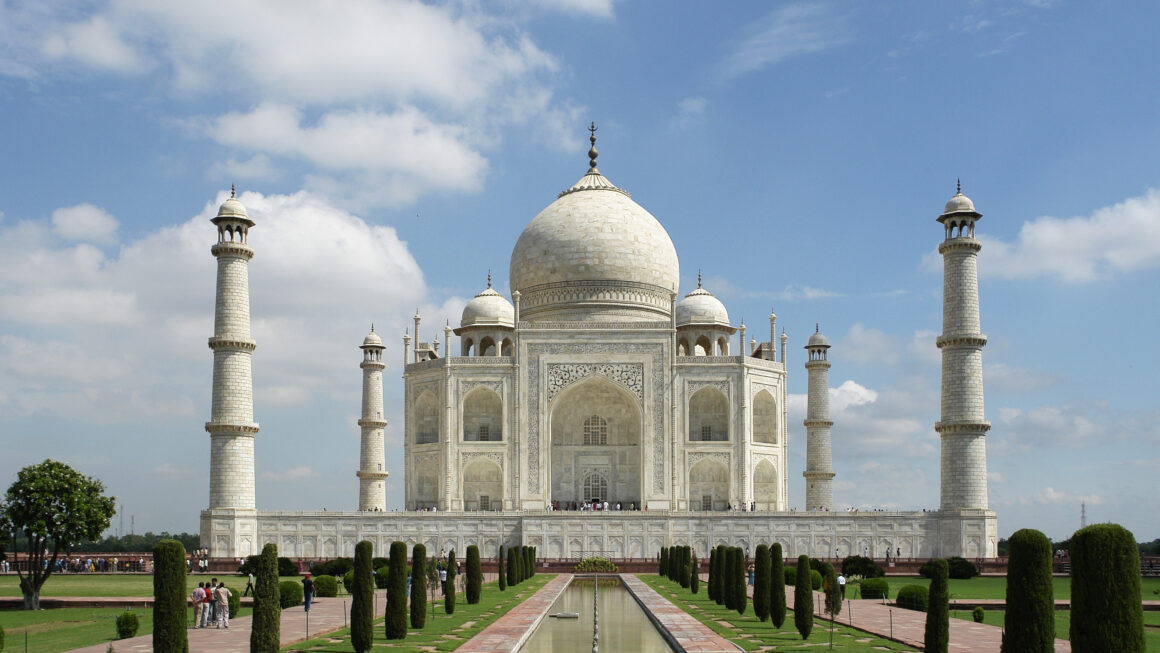The Taj Mahal is a world-renowned mausoleum located in Agra, Uttar Pradesh, India. It was commissioned in 1632 by Mughal Emperor Shah Jahan in memory of his beloved wife, Mumtaz Mahal. The construction took over 22 years and was completed around 1653, with the efforts of 20,000.Made of white marble, the Taj Mahal is a masterpiece of Mughal architecture, blending Persian, Indian,
Under the golden glow of the setting sun, Aarav and Meera stood before the Taj Mahal, their fingers entwined. The white marble monument shimmered, whispering tales of undying love.
“Shah Jahan built this for his beloved Mumtaz,” Meera said, her voice filled with admiration. “Imagine a love so strong that it created something so timeless.”
Aarav smiled, pulling out a small velvet box. “Then let’s make our love just as eternal.” As he knelt, Meera gasped, her eyes welling with tears.
“Meera, will you be my forever?”
Overwhelmed with emotion, she nodded, and the ring slid onto her finger, gleaming in the moonlight. The Taj Mahal stood as their silent witness—a monument of love, now entwined with their own story.
Hand in hand, they walked away, their hearts beating as one, knowing that centuries later, just like the Taj, their sign of love each other too, would live on in the whispers of the wind.
The Taj Mahal, built in the 17th century, was commissioned by Emperor Shah Jahan in memory of his wife Mumtaz Mahal. Constructed over 22 years by thousands of artisans, its intricate carvings, calligraphy, and perfect symmetry symbolize eternal love. This UNESCO World Heritage Site, blending Persian, Indian, and Islamic architecture, continues to captivate millions worldwide, a timeless testament to devotion and craftsmanship.
The Eternal Love of Mumtaz and Shah Jahan
The grand court of the Mughal Empire, Prince Khurram, who would later be known as Emperor Shah Jahan, fell in love with a beautiful Persian princess, Arjumand Banu Begum. She was not just a vision of beauty but a woman of intelligence and grace. From the moment he saw her, he knew she was the one.
In 1612, they were married, and Shah Jahan gave her the title Mumtaz Mahal, meaning “The Chosen One of the Palace.” Their love was legendary—she was his confidante, his advisor, and his greatest joy. Mumtaz accompanied him everywhere, even on military campaigns, never leaving his side.
However, their love story took a tragic turn in 1631 when Mumtaz Mahal died while giving birth to their 14th child in Berhampur. Her last wish was for Shah Jahan to build something so beautiful that the world would never forget their love. Heartbroken, the emperor vowed to fulfill her wish.
For over two decades, 20,000 artisans worked tirelessly to create the Taj Mahal, a masterpiece of white marble, adorned with intricate carvings, Persian calligraphy, and precious stones. It became a symbol of eternal love, standing on the banks of the Yamuna River, whispering the tale of a love that time could never erase.
Shah Jahan spent his final years imprisoned by his son Aurangzeb in the Red Fort, gazing at the Taj Mahal from a distance, longing to reunite with Mumtaz. When he passed away in 1666, he was laid to rest beside her in the grand mausoleum. Even in death, their love remained inseparable, immortalized in the heart of India’s most cherished monument. The Taj Mahal is not just a marvel of architecture—it is a love letter written in stone, a testament to the timeless love between Shah Jahan and Mumtaz Mahal.

The Aftermath of the Taj Mahal: A Tale of Time and Turmoil
After Shah Jahan’s death in 1666, the Taj Mahal remained a symbol of eternal love, but its fate was far from peaceful. As history unfolded, the magnificent monument saw periods of neglect, plunder, and restoration.
Aurangzeb’s Rule & Decline (17th – 18th Century)
Shah Jahan’s son, Aurangzeb, focused on military expansion rather than the arts, leading to the gradual decline of the Mughal Empire. Although he maintained the Taj Mahal, there were fewer resources for its upkeep. With the empire’s fall in the 18th century, the once-glorious monument began to suffer for taj mahal.
Plunder & British Loot (18th – 19th Century)
The 18th century, as Mughal power weakened, invaders such as the Jats and Marathas looted the Taj Mahal, stripping it of its precious gems, gold, and silver decorations. Later, during British colonial rule in the 19th century, Lord William Bentinck even considered dismantling the Taj Mahal and auctioning its marble in London! However, this idea was abandoned due to a lack of buyers.
British Restoration & Colonial Influence (19th Century)
Recognizing its significance, the British Viceroy, Lord Curzon, ordered a major restoration of the Taj Mahal in the early 20th century. The gardens were redesigned in the English style, and much of the structure was repaired, saving it from complete ruin abot taj mahal..
Post-Independence & Modern Preservation (20th – 21st Century)
After India gained independence in 1947, the Taj Mahal became a protected heritage site. However, it faced threats from pollution, acid rain, and even war. During the Indo-Pak wars of 1965 and 1971, the monument was camouflaged to prevent aerial bombings.
Today, the Taj Mahal is a UNESCO World Heritage Site and one of the New Seven Wonders of the World. Despite environmental concerns, restoration efforts continue to preserve its legacy, ensuring that Shah Jahan and Mumtaz Mahal’s love story remains alive for generations to come.
The Taj Mahal, born from love, and sign for love mumtaj and Shajahan.🕌❤️

